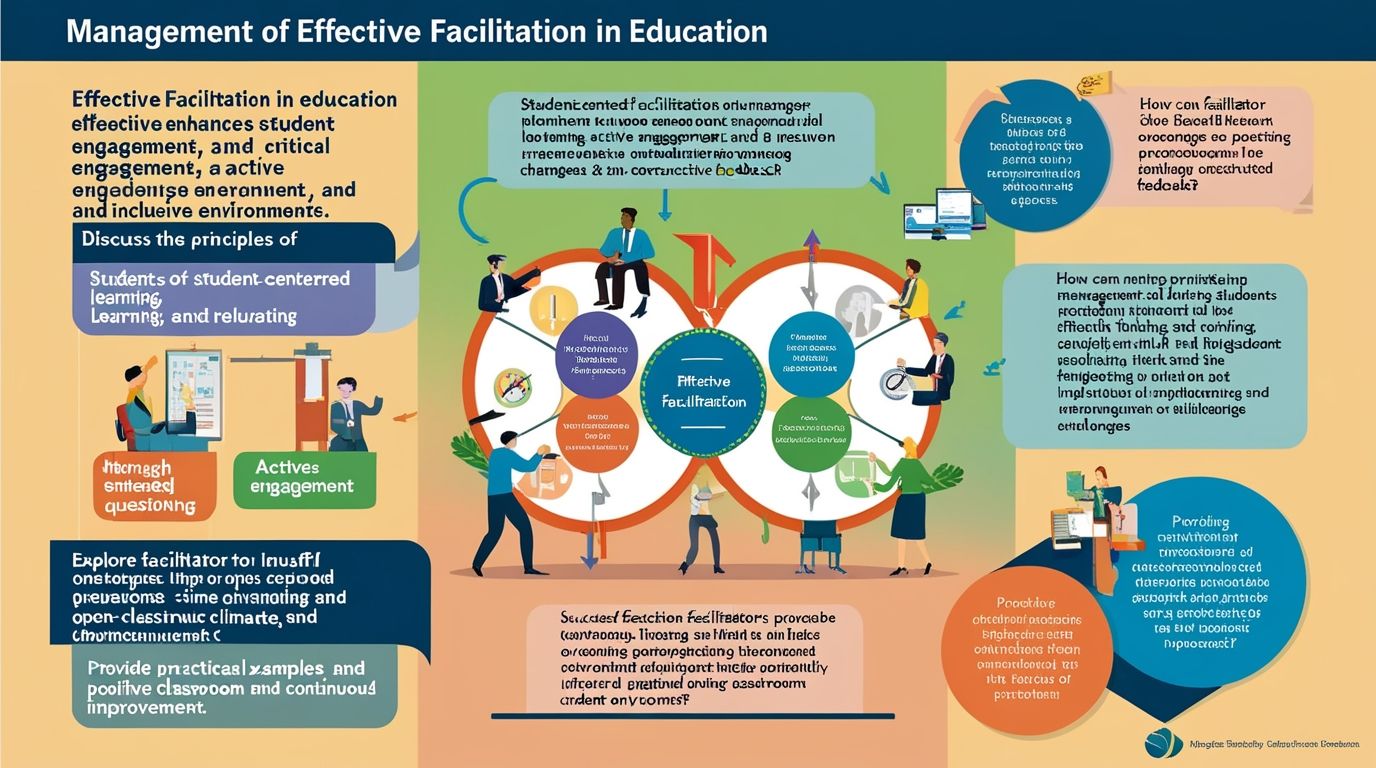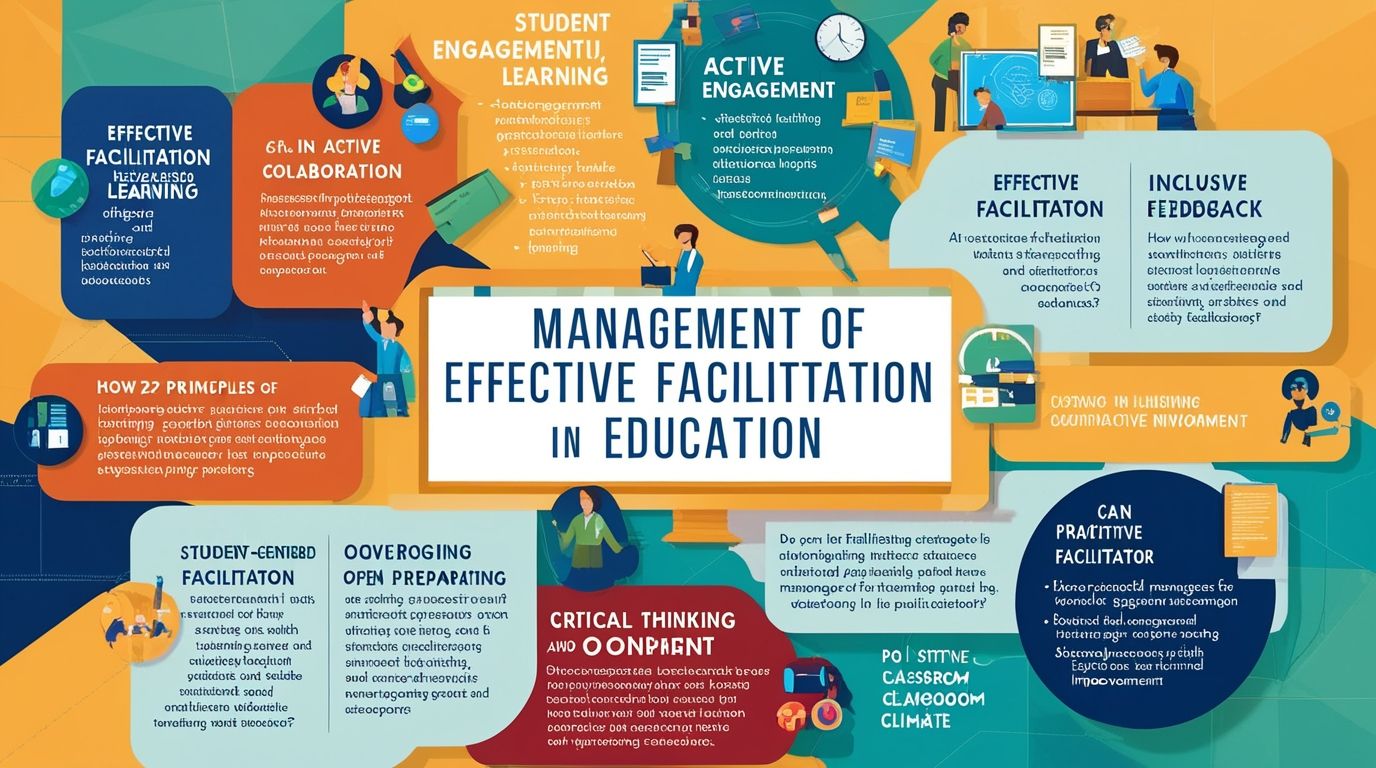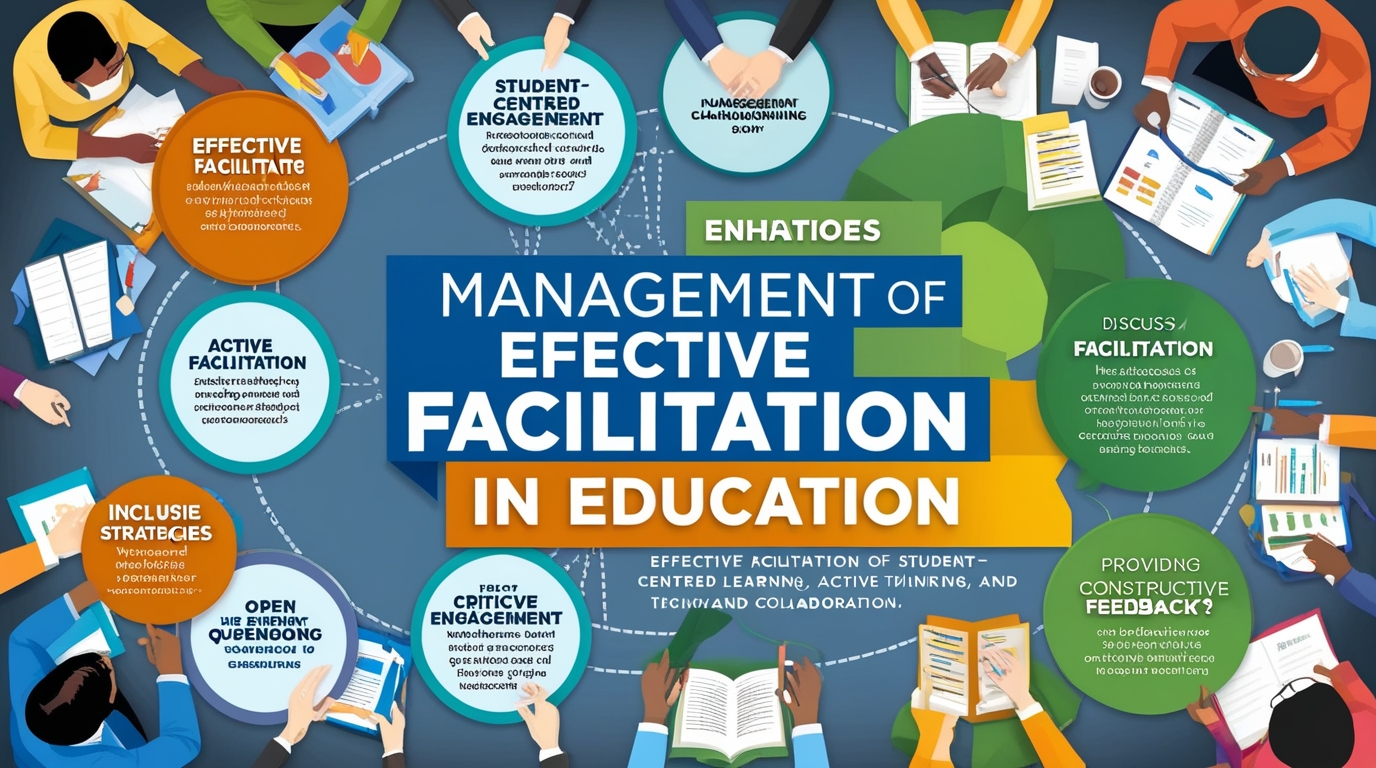Introduction
Management of Effective Facilitation in Education is crucial for fostering an engaging and productive learning environment. It involves guiding students through the learning process, encouraging participation, and creating opportunities for deep understanding. This article explores the principles of effective facilitation, its benefits, strategies for implementation, and tips for overcoming common challenges.
Principles of Effective Facilitation
- Student-Centered Learning: Effective facilitation focuses on student needs, interests, and learning styles. Facilitators act as guides, helping students take ownership of their learning rather than dictating information.
- Active Engagement: Facilitators encourage active participation through discussions, hands-on activities, and collaborative projects. This approach helps students apply their knowledge and develop critical thinking skills.
- Inclusive Environment: Creating an inclusive environment where all students feel valued and respected is essential. Effective facilitators ensure that every student has the opportunity to participate and contribute.
- Feedback and Reflection: Regular feedback helps students understand their progress and areas for improvement. Facilitators also encourage reflection, allowing students to think critically about their learning experiences.

Benefits of Effective Facilitation
- Enhanced Learning Outcomes: When students are actively engaged and take ownership of their learning, they are more likely to retain information and develop a deeper understanding of the material.
- Development of Critical Skills: Effective facilitation helps students develop essential skills such as critical thinking, problem-solving, communication, and collaboration. These skills are crucial for success in academic and professional settings.
- Increased Motivation: A student-centered approach that values student input and participation can increase motivation and enthusiasm for learning. When students feel that their contributions matter, they are more likely to be invested in their education.
- Positive Classroom Environment: An inclusive and respectful classroom environment promotes positive relationships among students and between students and the facilitator. This environment fosters a sense of community and support.
Strategies for Effective Facilitation
- Prepare Thoroughly: Effective facilitation requires careful planning. Facilitators should design lessons that are flexible and adaptable, with clear objectives and a variety of activities to cater to different learning styles.
- Use Open-Ended Questions: Asking open-ended questions encourages students to think critically and express their ideas. These questions can stimulate discussion and help students explore concepts more deeply.
- Encourage Collaboration: Group work and collaborative projects can enhance learning by allowing students to share ideas and learn from one another. Facilitators should create opportunities for students to work together and build teamwork skills.
- Be an Active Listener: Facilitators should actively listen to students’ contributions, showing that their ideas are valued. This approach encourages more participation and helps facilitators understand students’ perspectives.
- Provide Constructive Feedback: Timely and specific feedback helps students improve and stay motivated. Facilitators should focus on strengths as well as areas for improvement, providing clear guidance on how to progress.
- Create a Safe Learning Environment: Students are more likely to participate and take risks when they feel safe and supported. Facilitators should establish ground rules for respectful communication and model inclusive behavior.

Overcoming Common Challenges
- Time Management: Balancing the need for thorough exploration of topics with time constraints can be challenging. Facilitators should prioritize key concepts and be flexible, adjusting the pace as needed.
- Student Reluctance: Some students may be hesitant to participate in discussions or activities. Facilitators can build confidence by starting with low-stakes activities, encouraging participation, and creating a supportive environment.
- Diverse Learning Needs: Catering to a wide range of abilities and learning styles requires flexibility and creativity. Facilitators should use a variety of teaching methods and be prepared to offer additional support to students who need it.
- Maintaining Focus: Keeping students focused and on task can be difficult, especially in longer sessions. Facilitators can use a variety of activities and breaks to maintain energy levels and keep students engaged.
Practical Examples
Example 1: Socratic Seminars
Socratic seminars are a powerful tool for facilitating deep discussions. In a literature class, for example, the facilitator might pose an open-ended question about a novel. Students then discuss the question in a circle, with the facilitator guiding the conversation and encouraging all students to contribute. This method promotes critical thinking and allows students to explore complex ideas collaboratively.
Example 2: Project-Based Learning
In a science class, the facilitator might implement a project-based learning approach where students work in groups to design and conduct an experiment. The facilitator provides guidance and support but allows students to take the lead in planning and executing their projects. This approach helps students develop problem-solving skills and learn through hands-on experience.
Example 3: Peer Teaching
Peer teaching can be an effective way to facilitate learning. In a history class, students might be assigned to research different historical events and teach their peers about them. The facilitator supports students in their research and presentation preparation, then guides the class discussion following the presentations. This strategy helps students take ownership of their learning and develop presentation skills.
Tips for Successful Facilitation
- Build Rapport: Establishing a positive relationship with students can enhance the facilitation process. Taking time to get to know students and showing genuine interest in their learning can build trust and respect.
- Be Flexible: Effective facilitators are adaptable and responsive to the needs of their students. Being open to changing plans and trying new approaches can enhance the learning experience.
- Foster a Growth Mindset: Encouraging a growth mindset helps students see challenges as opportunities for learning rather than obstacles. Facilitators should model this mindset and provide support and encouragement.
- Reflect and Improve: Continuous reflection and improvement are key to effective facilitation. Facilitators should seek feedback from students and colleagues, reflect on their practices, and be open to making changes.
Conclusion
Effective facilitation in education is essential for creating engaging, inclusive, and dynamic learning environments. By focusing on student-centered learning, encouraging active engagement, and fostering a positive classroom climate, facilitators can enhance learning outcomes and help students develop critical skills. With thoughtful preparation, flexible strategies, and a commitment to continuous improvement, educators can successfully manage effective facilitation and transform the educational experience for their students.

ib0v4g
gsvpn0
49wojp
Hi, just required you to know I he added your site to my Google bookmarks due to your layout. But seriously, I believe your internet site has 1 in the freshest theme I??ve came across. It extremely helps make reading your blog significantly easier.
d4nj8f
Wake up your way with this premium CD player alarm clock radio. Whether you prefer to rise with the AM/FM radio, your favorite CD, or a standard buzzer, this versatile alarm clock with CD player has you covered. Its intuitive design includes dual alarms, a large digital display, snooze/sleep timers, and USB charging for your phone. Enjoy high-quality stereo sound from a compact unit that fits easily on any bedside table or shelf. The best clock radios with CD player combine retro functionality with modern convenience—and this one leads the pack.
Hello.This article was extremely remarkable, particularly since I was looking for thoughts on this topic last Friday.
Very efficiently written story. It will be beneficial to anybody who usess it, including me. Keep up the good work – looking forward to more posts.
I am really loving the theme/design of your website. Do you ever run into any internet browser compatibility problems? A couple of my blog visitors have complained about my website not working correctly in Explorer but looks great in Opera. Do you have any advice to help fix this problem?
You are my aspiration, I possess few blogs and very sporadically run out from brand :). “No opera plot can be sensible, for people do not sing when they are feeling sensible.” by W. H. Auden.
Generally I don’t read post on blogs, but I would like to say that this write-up very forced me to try and do it! Your writing style has been surprised me. Thanks, quite nice article.
It’s hard to find knowledgeable people on this topic, but you sound like you know what you’re talking about! Thanks
Great write-up, I’m regular visitor of one’s blog, maintain up the nice operate, and It’s going to be a regular visitor for a long time.
Thanks for another informative site. Where else could I get that type of info written in such a perfect way? I have a project that I’m just now working on, and I have been on the look out for such information.
It’s onerous to seek out educated people on this topic, but you sound like you already know what you’re talking about! Thanks
It is best to take part in a contest for top-of-the-line blogs on the web. I will advocate this website!
naturally like your web-site but you have to test the spelling on quite a few of your posts. A number of them are rife with spelling issues and I find it very bothersome to tell the truth nevertheless I’ll definitely come back again.
Good write-up, I am regular visitor of one¦s web site, maintain up the excellent operate, and It’s going to be a regular visitor for a lengthy time.
I have been exploring for a little for any high quality articles or blog posts in this sort of space . Exploring in Yahoo I eventually stumbled upon this site. Studying this information So i¦m satisfied to show that I’ve a very just right uncanny feeling I discovered just what I needed. I most no doubt will make certain to don¦t disregard this web site and give it a look regularly.
Some truly nice stuff on this site, I love it.
Hello! I just wanted to ask if you ever have any issues with hackers? My last blog (wordpress) was hacked and I ended up losing several weeks of hard work due to no backup. Do you have any solutions to protect against hackers?
Great – I should certainly pronounce, impressed with your web site. I had no trouble navigating through all the tabs as well as related information ended up being truly simple to do to access. I recently found what I hoped for before you know it at all. Reasonably unusual. Is likely to appreciate it for those who add forums or anything, website theme . a tones way for your customer to communicate. Nice task.
Would you be focused on exchanging hyperlinks?
Wow, incredible weblog format! How long have you been running a blog for? you make blogging glance easy. The full look of your web site is wonderful, as neatly as the content material!
Hi my family member! I want to say that this post is amazing, nice written and come with approximately all significant infos. I would like to see extra posts like this .
Great job on this
Interesting take on risk assessment! Seeing platforms like phww app casino prioritize easy deposits (GCash!) feels smart for accessibility & responsible gaming. It’s all about managing variance, right?